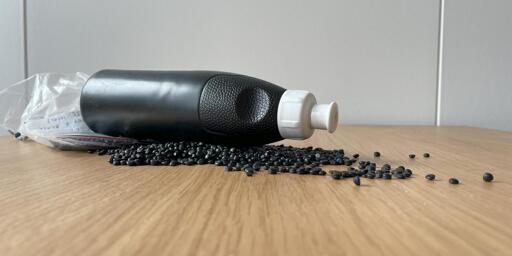Over 80 chemicals!
What bullshit scaremongering is this? There’s like 80 chemicals in a banana. Some of them are even radioactive!
There are even over 100,000 distinct chemicals in a banana. Probably over 1M. Horrified whenever I see somebody eat one. Only plastic food pellets for me please.
That’s almost fair. The difference is: a banana is a living organism, and very few synthetic materials are supposed to have 80 differently-identifiable chemicals in them. This melange of death here is shit like dioxins, plasticizers, decomposition products, dyes and other additives, as well as the reaction products of all of THAT shit mixing at high temp in the melted plastic. If you aren’t afraid, then I don’t know how to help you, child.
Brushing this off with some trite banana comparison is just making a Robert Kehoe out of yourself.
a banana is a living organism
So what? So is poison ivy. I wouldn’t recommend eating it.
very few synthetic materials are supposed to have 80 differently-identifiable chemicals in them
I’m sorry but - what the fuck are you talking about? Who is deciding how many different chemicals should be in any given material? What sort of of ridiculousness is this?
This melange of death here is shit like dioxins, plasticizers, decomposition products, dyes and other additives, as well as the reaction products of all of THAT shit mixing at high temp in the melted plastic.
Which is my point - the NUMBER of items in a given material is just scare-mongering BS. The actual ingredients is what matters.
If you aren’t afraid, then I don’t know how to help you, child.
If you don’t understand that the count of the number of chemicals in a thing doesn’t relate to that thing’s toxicity then I can’t help you either kid.
It’s all good man, those chemicals are also present in living organisms too, I guess… /s
The fuck did you smoke, did you even read?
We identified common plastics chemicals, including UV-stabilizers and plasticizers, as well as chemicals that are not used as plastics additives, including pesticides, pharmaceuticals and biocides.
Water is a chemical. The point was using an arbitrary number and an arbitrary descriptor means absolutely fuck all.
What’s the point of specifying ‘in a single pellet’? All pellets of a batch are the same. You don’t get 160 chemicals in two pellets.
Is it normal to find 80 chemicals in say a plastic bottle of water? I have no frame of reference.
As a chemist, but without organics specialization (my specialty is rocks), I think that what we’re seeing here is a collection of three main things, aside from polyethylene:
- decomposition byproducts: plastics break down under heat, stress and in light. It’s not surprising that some of their breakdown byproducts might be found in plastic that has been melted into a new shape.
- dyes: plastic is dyed with different additives, and there are a LOT of different colors of plastic being recycled. They usually try to keep the colors generally consistent among batches for recycling, but the dyes that make a sprite bottle green are different from the ones that make a dasani bottle teal.
- Plasticizers and other additives: the things the corporations add to their plastics just to eke out that 1 cent of savings from thinner, more durable plastic, or to get the texture just right, are insane. These are things like BPA. There are loads of them, and every plastic has different types. Some of them also have different heat tolerances, but it’s not like the recyclers are keeping track.
So, yeah, be afraid. There’s a metric fuckton of shit in there, and literally no one knows what it all is, let alone how much of it made it through the manufacturing, use, recycling and manufacturing process without becoming prone to leaching. Virtually all plastic recycling is a scam perpetrated by the corporations to get us to blithely ignore how they are destroying the planet to save money, all while convincing us to blame ourselves.
Been a while since I was in a lab (I was mainly concerned with squishy, squidgy things like microbes, so not quite OChem either) but, this looks accurate to me with a minor bit of pedantry that I had to validate before mentioning. BPA is not actually a plasticizer but a monomer/co-monomer (it does frequently get incorrectly labeled as a plasticizer in retail products). Notably in polycarbonate, which is something like 90% BPA by mass.
A big issue with is the incomplete reaction of monomers, leading to things like room-temp leeching of unreacted BPA in polycarbonate (so glad that I took a Nalgene with me everywhere for years when I was younger /s).
You misspelled “a minor bit of pedantry”. Sorry. It had to be done.
Thanks for that. No apology necessary - that was rather hilarious.
Thanks! Edited to account for “and other additives”
All those chemicals are slightly different length hydrocarbon chains. Functionally, they are nearly identical.
Sucrose and cellulose are different-length chains of sugars, but that doesn’t mean they’re the same. Also, all of the additives in the many different types of melted-together plastic would beg to differ with your assessment.
There isn’t a biologically significant difference between clothing made from various grades of nylon, polyester, polypropylene, spandex, Lycra, acrylonitrile, etc. You probably wear clothing made from each of these families or similar, related materials, each comprised of dozens of “chemicals”.
But you’ll turn up your nose at the thought of several of these materials combined into a single pellet?
After it’s been exposed to use and light for who knows how long, and after being melted together at high temperatures, inevitably higher than the decomposition temperatures of at least a few of the dyes and additives in there, because precisely zero effort has been put in to purify it before being slagged? Yes I will turn my nose up, and you should too. No self-respecting chemist sniffs chemical cocktails of unknown provenance.
ETA: Also, your clothing note is a completely false equivalence, because the chemical at issue here is polyethylene, which has a far greater range and prevalence of additives than those polymers you named for use in clothing.
It’s to highlight how common and widespread the contamination is.
You could say “We found 80 chemicals across a dozen facilities”, but showing how all 80 chemicals were in a single pellet highlights how widespread the contamination is.
Maybe there’s only 80 chemicals in a pellet, as in, 80 very long molecules.
A new study with researchers from University of Gothenburg and Leipzig shows that recycled polyethylene plastic can leach chemicals into water causing impacts in the hormone systems and lipid metabolism of zebrafish larvae.
“Recycled plastic can leach chemicals into water” would have been a better headline. “Recycled plastic can leach X% more chemicals into water than ‘virgin’ plastic” would be even better.
Still, I better not house my zebrafish in a recycled polyethylene aquarium, I guess.
if one were to stop and think reasonably for a moment about what “recycled plastic” is, the term more or less literally means “a toxic cocktail of petrochemicals”
if the problem is toxic petro-chemicals maybe the solution is the complete dismantling of the fossil fuel industry by any means
I like the way you think.








